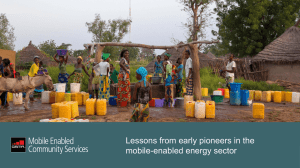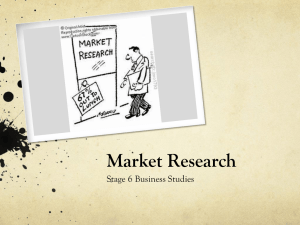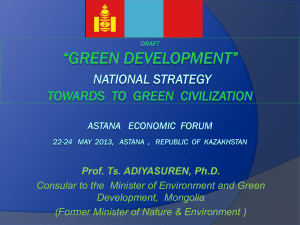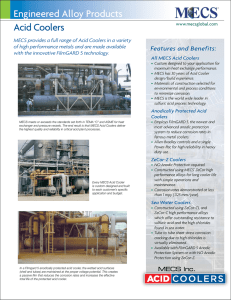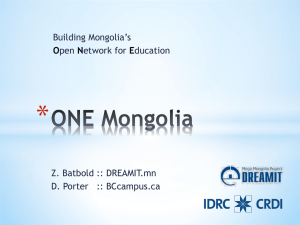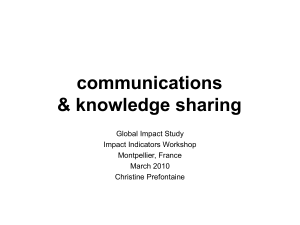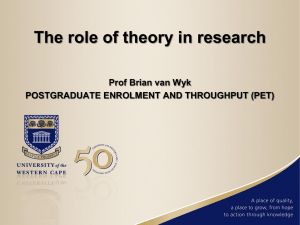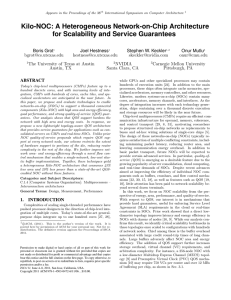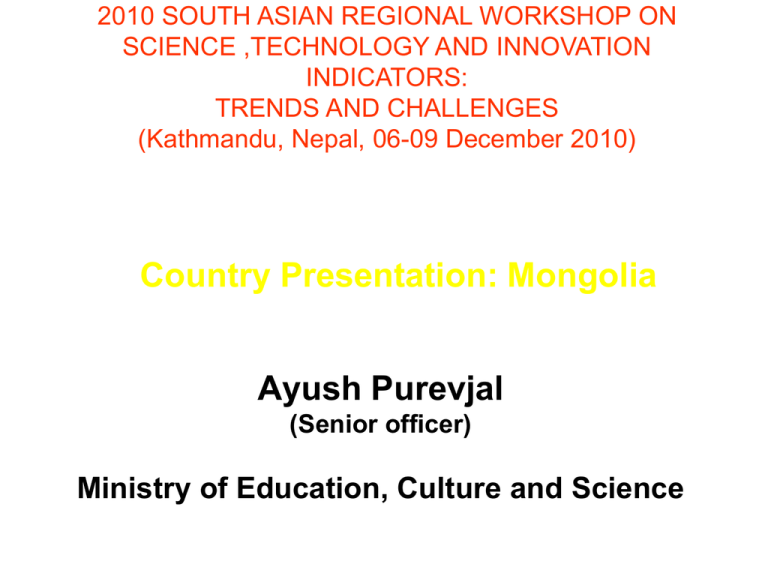
2010 SOUTH ASIAN REGIONAL WORKSHOP ON
SCIENCE ,TECHNOLOGY AND INNOVATION
INDICATORS:
TRENDS AND CHALLENGES
(Kathmandu, Nepal, 06-09 December 2010)
Country Presentation: Mongolia
Ayush Purevjal
(Senior officer)
Ministry of Education, Culture and Science
Contents
1.
2.
3.
4.
Country profile
Scientific system
Collecting S&T statistics
Main results of the collected S&T
statistical data
5. Major problems in collecting S&T
statistics
1. Country profile
Map of Mongolia
What we have…
• Huge territory - 1.56 mln.sq.km (11 times bigger
than Nefal, 2.8 times bigger than France)
• Rich of natural resources - Copper, Molybdenum,
Gold, Coal, Gas…
• Animal husbandry (40.0 mln: Cow-2.6, Sheep-19.3,
Goat-19.6, Horse-2.2, Camel-0.28) –NSO,2009
• Cashmere (Second largest exporter)
• Educational level of people: (about 20% of
Government budget dedicated to Education)
- literacy rate 97.6% (NSO, 2009)
- 113 universities, institutes and colleges
What we do not have…
• Few population – 2.73 mln., NSO, 2009 (11 times less
than Nepal)
• Extreme (severe continental) climate - +/-35 C
• No sea access (Between two big Powers: Russia and
China)
• Small market
• No experience in market economy (during 70 years
isolated socialist system )
• Economy based on agriculture (animal husbandry) and
row material export
• GDP per capita -1669 USD ( NSO, 2009)
2. Scientific system
Soviet model of R&D system
(before 1990)
Universities
Institutes under
the Academy
of Sciences
Research institutes
under ministries
Education
Basic research
Applied research
and development
S&T under central-command system
Government
Research Institutes
under Ministries
State-owned
Industry
Government-funded R&D
R&D during the Transition
(since 1990)
During 1990-1997:
─
─
─
─
Scientific expenditure decreased
Number of researchers decreased 2.5 times
Number of research organizations decreased from 91 to 32
Material investment for laboratory equipments was stopped
After 1997:
─ Reorganization of universities and research institutes
─ Tendency to increase budget and number of researchers
Organizational Structure of Mongolian
Scientific sector (since 1990)
Government
NCST
Other Ministries
MECS
MAS
Scientific Research
Institutes under MAS
NSTF
Scientific
Research
Institutes
Scientific, technological
and Production Corporations
Universities
3. Collecting S&T statistics
Legislative framework of S&T statistics
Legislation acts:
• Law on statistics (MP, 1997)
• Law on S&T (MP, 1998)
Main policy documents:
State policy on S&T (MP, 1998)
S&T Master plan (2007-2020) of Mongolia (MG,
2007)
Programme for developing of national innovation
system in Mongolia (MG, 2007)
S&T data collection process
UNESCO
National statistical office (NSO)
Official statistical data
Ministry of Education, Culture
and Science (MECS)
Official and administrative statistical data
Scientific research institutions
Universities
By data collection forms
(questionnaires)
Questionnaire UIS/ST
Dissemination formats of results of S&T
statistics
Publication (annual):
• “Mongolian statistical yearbook”, NSO
(Mongolian/English)
• “Statistical abstract of Education, Culture and Science
sectors”, MECS statistical yearbook (Mongolian)
Electronic (internet):
Statistical data of Education, Culture and Science
sectors by NSO (Mongolian/English)
Website: http://www.nso.mn
Statistical database of Education, Culture and Science
sectors by MECS (Mongolian)
Website: http://www.mecs.gov.mn
Coverage of R&D statistics (by sector)
Degree of coverage
Sector
Completely
covered
Business
enterprise
Government
Partially covered
Not covered
X
X
Higher education
X
Private non-profit
Category not applicable. It is included into Business
enterprise.
4. Main results of the collected
S&T statistical data
Number of institutions covering R&D
statistics (data of MECS)
Number of institutions
Sector
Type of institutions
2005
2009
Business
enterprise
Private Scientific Research
Institutions
47
50
Government
Public Scientific Research
Institutions
4
9
Higher
education
Universities
5
9
56
68
Total
Scientific research institutions
• Scientific research institutions (by forms):
– Scientific research institutions of MAS – 22
– Scientific, technological and production corporations – 5
– Scientific research institutions of public universities – 14
– Scientific research institutions under Ministries – 9
– Private scientific research institutions – 9
• Scientific research institutions (by field of science):
– Engineering and technology– 12
– Natural sciences– 20
– Agricultural sciences – 7
– Medical and health sciences – 5
– Social sciences and Humanities – 15
Source: MECS, 2009
Total full-time R&D personal by occupation
(Headcount data for statistics of MECS)
Occupation
Year
Total fulltime
R&D
personal
2009
2483
1748
137
598
2008
2420
1723
125
572
2007
2379
1740
120
519
2006
2316
1707
114
495
2005
2283
1731
81
471
Researchers
Engineering
Other
(including
and technical supporting
Administrative
staff
staff
staff)
Total full-time R&D personal by sex
(Headcount data for statistics of MECS)
Total full-time R&D
personal
Year
TOTAL
% of
Female female in
total
of which: Researchers
(including Administrative
staff)
% of
TOTAL Female female in
total
2009
2483
1262
50.83
1748
841
48.11
2008
2420
1220
50.41
1723
816
47.36
2007
2379
1189
49.98
1740
837
48.10
2006
2316
1163
50.22
1707
822
48.15
2005
2283
1118
48.97
1731
819
47.31
Total full-time R&D personal by sector of employment
(Headcount data for statistics of MECS, 2009)
Researchers
(including
Administrative
staff)
Total
full-time R&D
personal
% of
total
2483
100.0
1748
100.0
Business
enterprise
171
6.89
95
5.43
Government
2153
86.71
1538
87.99
Higher
education
159
6.40
115
6.58
Sector
TOTAL
% of
total
Researchers by formal qualification and sector of
employment
(Headcount data for statistics of MECS, 2009)
Sector
Qualification
Total
researchers
TOTAL
% of
qualification
Higher
in Total
education researchers
Business
enterprise
Government
1748
95
1538
115
100.00
I.ISCED 6
531
18
457
56
30.40
II.ISCED 5A
1217
77
1081
59
69.60
III.ISCED 5B
-
-
-
-
-
IV. All other
qualifications
-
-
-
-
-
Researchers by field of science and sector of
employment
(Headcount data for statistics of MECS, 2009)
Business
enterprise
Government
Higher
education
% of field of
science in
Total
researchers
1748
95
1538
115
100.00
I. Natural
sciences
698
40
619
39
39.93
II. Engineering
and technology
201
26
126
49
11.50
III. Medical and
health sciences
196
18
174
4
11.21
IV. Agricultural
sciences
301
11
274
16
17.22
V. Social
sciences and
humanities
352
0
345
7
20.14
Field of
science
Total
researchers
TOTAL
Sector
Researchers by age structure
(Headcount data for statistics of MECS)
Total researchers per thousand total
employments
(data for statistics of MECS and NSO)
Indicators
2000
2005
2009
Total employments (thousand
persons)
809.0
968.3
1006.3
Total researchers
1693
1731
1748
Total researchers per thousand
total employments
2.09
1.79
1.74
Expenditure on R&D
(data for statistics of MECS and NSO)
Year
Total
expenditure
on R&D
Gross domestic product
(GDP), at current prices
Ratio to GDP,
%
2009
15987.1
6055794.3
0.26
2008
18070.7
6019838.1
0.30
2007
10410.0
4599541.5
0.23
2006
7701.1
3714952.9
0.21
2005
7231.2
2779578.3
0.26
Millions, Mongolian tugrik (T)
Sources of finds of R&D
expenditure
•
•
•
•
•
•
Government budget (central)
Local budget
Private organizations
Higher education
Foreign funds
Money from basic and supporting activities
of scientific research organizations
• Other resources
Expenditure on R&D by sources of funds
(data of MECS, 2009)
Total
expenditure
Source of funds
Business
Government
enterprise
Higher
education
Fund of
abroad
Not
specified
15987.1
582.2
12358.2
394.7
289.7
2362.3
100%
3.6
77.3
2.5
1.8
14.8
Expenditure by sector of performance:
Government -80.9%
Business enterprise -6.9%
Higher education -12.2%
Most of R&D carried out in public sector research institutes and universities
Central government main source of R&D funding
Private sector R&D not assessed
Expenditure by type of R&D activity
(%, data MECS, 2009)
5. Major problems in collecting
S&T statistics
Major problems in collecting S&T statistics in
Mongolia:
• Not established a national integrated system of S&T information
and statistics.
• Non-existence of completely information or data on Industry and
Business enterprise involvement into the S&T sector and that
makes difficult to determine the current condition of S&T sector in
Mongolia.
• Sometimes S&T statistical data and methodology on data
collection is different in Mongolia. For example: we don’t use the
“Full-time equivalence (FTEs)” indicator and don’t know how to
calculate them. Also some of indicators such as (“researchers”,
“publications”) should be calculated in accordance with the
internationally recognized methods.
Major problems in collecting S&T statistics in
Mongolia:
• The importance and role of the S&T statistical
information is very limited and public awareness on the
S&T statistical information is poor in Mongolia.
• Capacity of Institutional statisticians in the S&T sector is
very low and un experienced.
• Use of advanced ICT is the main negative factor for
collecting, processing and aggregating statistical data as
well as distributing this information to users.
• Lack surveys on monitoring and evaluation of S&T
statistical information and indicators at qualified level.
Future suggestions and actions to improve the
S&T statistics in Mongolia:
• Collecting and integrating S&T information and statistics
according to international classification and standards: To
increase the number of internationally comparable S&T
statistical data; to develop a guideline on definitions of the
main S&T indicators and methodologies these calculations.
• Calculating an Industry and Business enterprise
involvement into the S&T sector: Expanding the degree of
coverage of the Business enterprise and Industrial
institutions to the S&T statistical information; under this
framework need to integrate the National Statistical Office
of Mongolia, and use its human resource and national
statistical information network capacity.
Future suggestions and actions to improve the
S&T statistics in Mongolia:
• Collecting and integrating innovation statistics and data
according to international standards: developing of Law
on Innovation; to determine the main indicators for
respective innovation statistics need to be developed.
• Introduction of modern advanced ICT (software and
hardware) for collecting, processing and aggregating of
S&T statistical information.
• With the purpose of improving the capacity and
exchange of experiences of the statistical officials, to
involve and invite to the International or national
seminars and training workshops widely.
Thank you very much !

